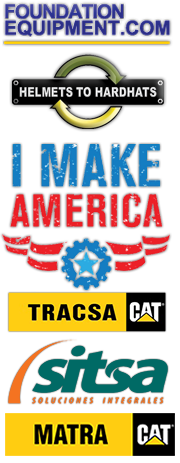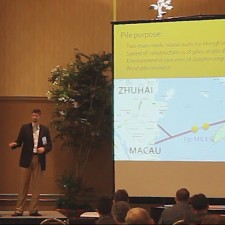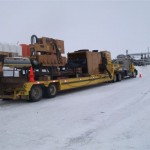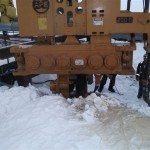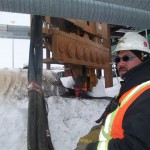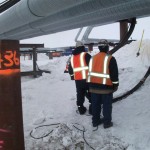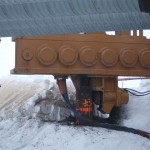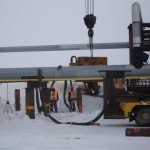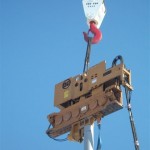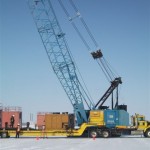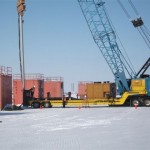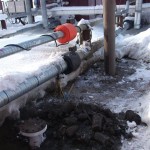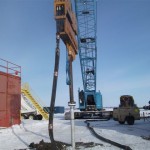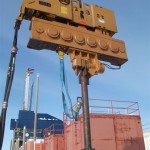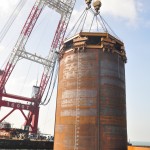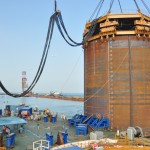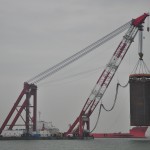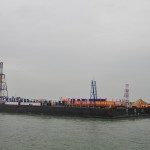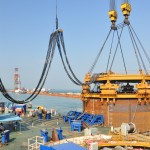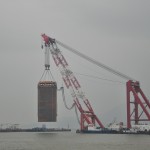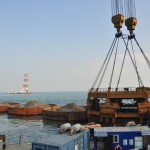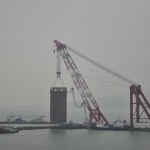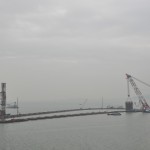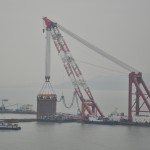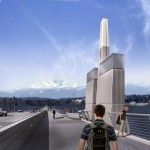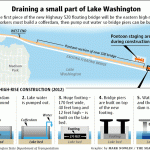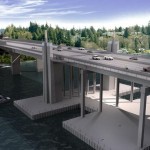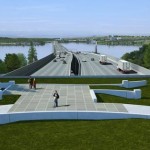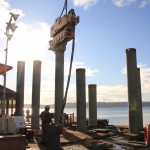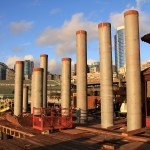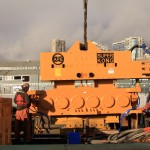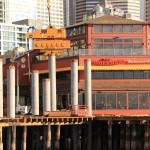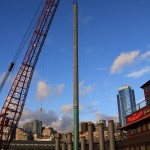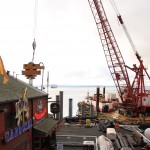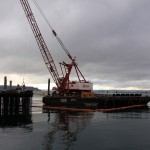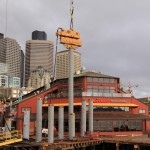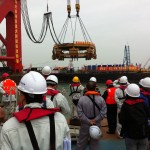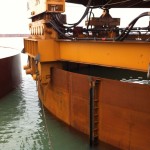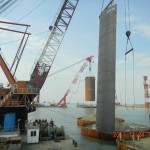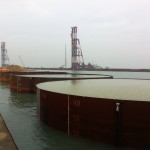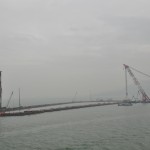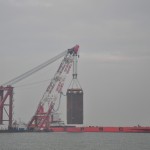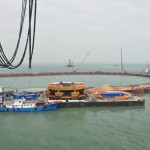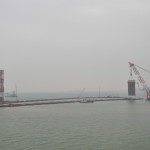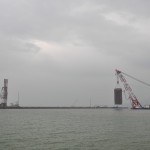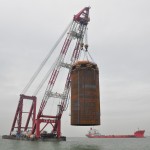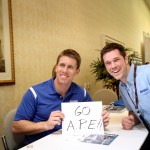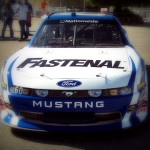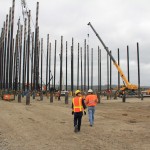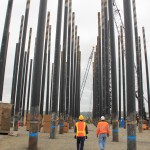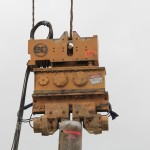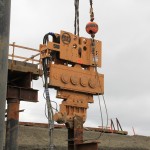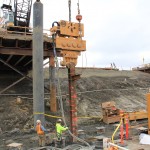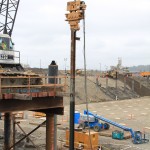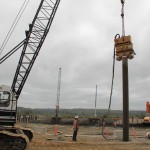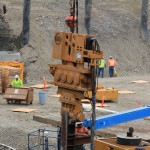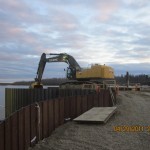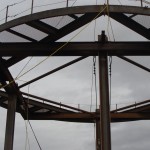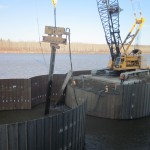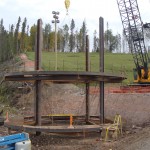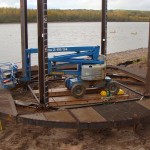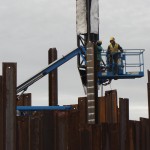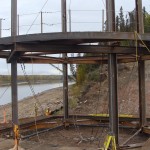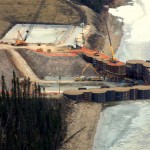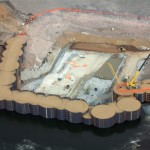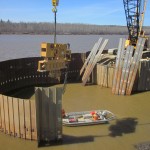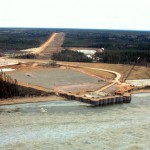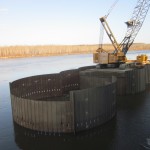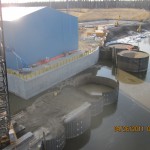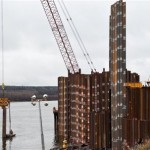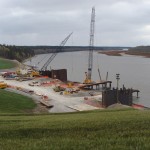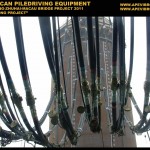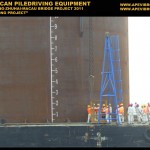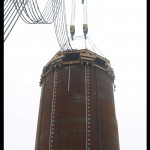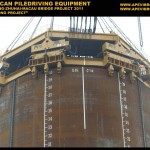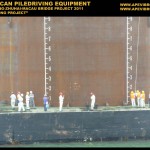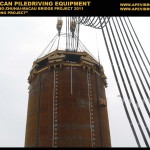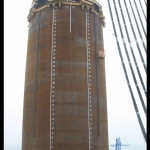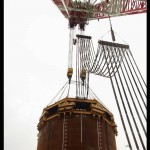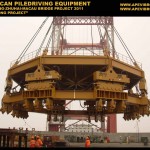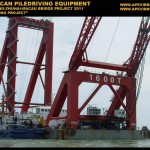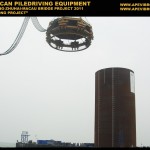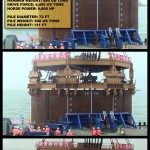DFI 2012 Superpile: Large Diameter Pile Presentation
APE was given the opportunity to present at DFI’s 2012 Superpile on the benefits, challenges and complexities of driving large diameter piles. The presentation was given by David White, the Managing Director of APE China. Along with Steve Gough, the APE China team and APE Corporate team, we all made the foundation work of Hong Kong-Zhuhai-Macau Bridge a reality. They worked tirelessly to design, negotiate and deliver the “OctaKong”, the largest Vibratory Driver Extractor to ever be seen on planet earth.
David White wrote an article back in December detailing the role that APE and our team played in constructing the foundation for the reclaimed islands of the bridge, this was after the final pile had been driven. During the process we have written several more articles with details on the construction of the bridge and APE’s continued involvement. We look forward to what future projects will bring with the benefits seen through the use of large diameter piles.
[tubepress video=”U18gkY-rSP4″]
Below are the links to all of the articles we have written over the past year on the OctaKong and the Hong Kong-Zhuhai-Macau Bridge:
- Final 72′ Pile Driven to Grade, OctaKong Project Finished
- APE Drives the World’s Largest Pile!
- APE China Successfully Drove the World’s Largest Sheet Pile
- Octakong and the Hong Kong-Zhuhai-Macau Bridge
- APE China Successfully Tests Tandem 200-6
- When the Competition Says “They Can Do It”… Talk to Someone Who Has “DONE IT” Call APE!
Peak Oilfield Service Drives Through Frozen Alaskan Ground with APE 200-6
We owe a big thanks to Shane McWhirk from Peak Oilfield Service and the APE Parts Department for getting us this story and pictures from Prudhoe Bay, Alaska. The APE 200-6 was used successfully in cold temperatures (-10 F thru -35 F) for driving the piles for Peak Oilfield Service’s job. The Hydraulic tank was insulated and heated with heat pads that were supplied electricity from a generator. Permafrost layers are between 6 to 15 feet making driving some of the toughest a vibratory driver/extractor could encounter. A 30 year crane operator from Florida that has put thousands of piles in the ground compares the permafrost layers to granite.
International Construction Magazine: New Direction for Chinese Construction
We recently received the 2012 January – February issue of International Construction Magazine, and we are more than pleased to see an article on the Hong Kong-Zhuhai-Macau Bridge project where the APE OctaKong was driving the largest diameter piles every driven in history. For those of you unfamiliar with the project, here is a rundown on the scope of the project courtesy of Wikipedia:
“The in-construction Hong Kong-Zhuhai-Macau Bridge is a series of bridges and tunnels that will connect Hong Kong, Macau and Zhuhai, three major cities situated on the Pearl River Delta in southern China. The proposed 50 km (31 mi) link is expected to cost US$10.7 billion.[citation needed] With its length, it would become one of the landmarks within the area. The longest bridge section will be 22.8 km (14.2 mi) long and include three cable-stayed spans between 280 m (920 ft) and 460 m (1,510 ft).[1][2] Construction formally began on 15 December 2009.[3] The bridge is due for completion in 2016.”
David White, Director of Operations of the APE China Office and Manufacturing facility wrote an article back in December detailing the role that APE and our team played in constructing the foundation for the reclaimed islands of the bridge, this was after the final pile had been driven. During the process we have written several more articles with details on the construction of the bridge and APE’s continued involvement. We look forward to helping the Chinese build quality foundations for any of their coming construction projects. Below are the links to all of the articles we have written over the past year on the OctaKong and the Hong Kong-Zhuhai-Macau Bridge:
- Final 72′ Pile Driven to Grade, OctaKong Project Finished
- APE Drives the World’s Largest Pile!
- APE China Successfully Drove the World’s Largest Sheet Pile
- Octakong and the Hong Kong-Zhuhai-Macau Bridge
- APE China Successfully Tests Tandem 200-6
- When the Competition Says “They Can Do It”… Talk to Someone Who Has “DONE IT” Call APE!
APE Vibratory Hammers Building the New Seattle 520 Floating Bridge
The Seattle Times just posted a news article this morning about the new 520 floating bridge project spanning Lake Washington just east of Seattle. The bridge has been in development for last couple years, with dry dock construction for the pontoon sections taking place in Aberdeen Washington (See Chris Wang’s article on the dry docks here). Construction on the actual bridge site has been in the prepping phases and is now ready for major foundation work which is slated to start next week.
The coming weeks will include huge foundations and concrete spans near shore, twin sloping transition spans that reach down to the lake, floating pontoons, and road decks fastened upon them. APE will be on the scene with a 600 Vibratory Driver extractor, the largest vibratory pile driver in the APE fleet will be pulling the outer casing for 12.5′ drilled shafts. We will also see an APE 200-6 driving the sheet piles for the cofferdams. See the Seattle Times new article here http://seattletimes.nwsource.com/html/localnews/2017862072_520bridge29m.html for more details.
Ferris Wheel on the Seattle Waterfront? You Got It! Courtesy of Manson and APE
Along with the on-going demolition of the Alaska way viaduct, a Seattle landmark second only to the Space Needle, rises a new attraction on Pier 57- a 175-foot-tall Ferris wheel. Pier 57 was originally built in 1902 as a rail-loading facility for a saw mill. Today, it houses a plethora of marine-oriented shops, restaurants, and even an antique carousel. Hal Griffith, owner of Pier 57, fears losing business due to the viaduct replacement and hopes a new waterfront attraction will keep the publics’ interest alive. With the loss of the Fun Forest at the Seattle Center, this will be the only Ferris wheel available in the city. Once completed with 41 air conditioned gondolas, it should prove to be quite an accommodating attraction to locals and tourists alike.
Manson Construction, a major player here in the PNW, was chosen to drive the foundation piles of this soon-to-be “landmark” on the water ward side of the existing pier. With a total of 53- 36” x .5” wall and 30” x .625” wall pipe piles on deck, the Manson crew set out to drive these piles with the APE Super Kong. What else would you want driving the piles for a 175-foot marine based Ferris wheel, right?
So far, the Manson crew has driven a dozen test piles. With some fine tuning of the equipment to account for the infamous Glacial till the Northwest is known for, the 150’ piles are down to grade. Some were driven only a couple of feet away from the Fisherman’s Restaurant & Bar. Needless to say, some diners became spectators and spectators became diners. Fair trade.
Today, the Manson crew is running production piles. Most are on 4:1 fore and aft batters. To accommodate the tight driving schedule and the layout of the pile driving grid, APE and Manson teamed up to outfit the Super Kong with a custom vibro sled fit for Manson’s leader system, as well as a custom swing arm pile gate. More pictures and updates to come!
Final 72′ Pile Driven to Grade, OctaKong Project Finished
On December 8th 2011, the APE “OctaKong” hammer drove it’s final pile to grade in front of a crowd of 200 people on the South China Sea. Many Engineers, officials, contractors, and China T.V. Stations came to witness the final pile drive to grade. In total, 120 piles were used to create the east and west man-made islands for the HongKong-Zhuhai-Macau bridge project. The largest pile was 72 feet in diameter, 180 feet high, and 660 US tons. The entire project lasted just under 7 months, an incredibly fast time to make two full island foundations. ZPMC, the Shanghai based company who fabricated the piles, could hardly keep up pile production with the driving speed of the project. At the fastest point the OctaKong drove 6 piles in 3 days. One of the biggest challenges of the East island was learning how to drive 72 foot diameter piles in complex soil conditions. When driving large diameter piles the soil conditions on one side of the pile can be very different than on the other side of the pile. At some points the right side of the pile was facing N47+ soil while the left side only saw only N15. Soil layers are not flat, which is not usually not a problem when driving small diameter piles, but when faced with super large piles often times one full side of the pile will cut through a soil layer for 10 feet before the other side of the pile hits the same layer. This creates a big challenge when trying to get the pile to go into the soil perfectly straight. These new challenges forced us to learn a new pile driving method specific to large diameter piles. No doubt a huge step for the pile driving industry for the future of even larger bridges, land reclamation, and wind power.
It was a surreal feeling to watch the last pile go into the ground after nearly 2 years of research and planning. As the pile reached it’s final feet many surrounding boats launched fireworks and large cheering could be heard as soon as the machine was shut off. It’s not very common in Chinese culture to see grown business men and engineers hugging and shouting, but as the OctaKong drove it’s last few feet I think it sent overwhelming joy throughout everybody who’s worked on the project, including myself. The timeline for this project was so tight that tensions were high for the last 7 months. I think everybody knew that if the OctaKong hammer broke for whatever reason the entire project had no chance to finish on time, and with no backup hammer, APE China felt the heat to make sure the project kept going smoothly. I’m glad to report that the OctaKong hammer never had even one day of downtime, something our APE team should be very proud of. The APE 200-6 tandem special is driving the final 37 foot shell-pile-walls over the next week and that project should conclude soon as well. Thank you to everybody who worked so hard on this project!
We are working on a 30 minute documentary for this project with some pretty amazing video and pictures. Please stay tuned for that to be released soon!
Should you have any specific questions about this project, I invite you to e-mail me or call at anytime. Phone: 253-872-0141 E-mail: stevec@apevibro.com
APE Photo Op with Carl Edwards
At APE today we are taking a moment to recognize one our most important vendors, Fastenal. They are responsible for many of the parts involved in putting together a diesel impact hammer, vibratory driver extractor etc. Jim Winn is our Fastenal representative at the APE headquarters here in Kent WA. For the most part he’s an all around good guy, especially when he went down to Florida for a Fastenal convention and had a chance to get a picture and autograph with Carl Edwards. For those who don’t know, Carl Edwards is the 2nd place driver in the Sprint Cup Series, following Tony Stewart. Jim Winn took his opportunity with Carl Edwards and got him to take a photograph with him holding a sign saying “GO APE!”. All of us at APE have to say (including Wayne), that’s pretty cool Jim, much appreciated!
Sprint Cup Series Rankings: http://www.nascar.com/races/cup/2011/data/standings.html
Kiewit-General Starts Off the SR520 Bridge Pontoons Project
If you’re in Aberdeen looking towards Gray’s Harbor, there’s a good chance you’ll spot what looks to be like someone has been planting a field of steel towers sticking 80’ out of the ground near a Chevrolet distribution plant. That is the location of the SR 520 pontoons casting basin project. Kiewit- General and WSDOT have teamed up to develop 55-acres of land into what will be the dry dock for the construction of 33 concrete pontoons to refurbish the SR 520 Bridge. 21 of these pontoons will be the largest ever built in Washington State and reach lengths upward of that of a football field. To date, Kiewit has driven over 800 of the 900 18” and 24” diameter pipe piles. They first drove these piles to grade with their D62-22 diesel impact hammer and then cut the piles off internally with a custom made tool. From there, the crew would fill the piles with peat and begin extracting the tops with the APE Model 50 vibro, which cleared a path for their excavators to begin extracting soil out of the basin foundation. On the other end of the jobsite where the crew had already completed excavation, the APE Model 200 vibro is working to drive the retaining walls for the casting basin as well as assembling Kiewit’s work trestle. I am proud to say that Kiewit- General has reported no major issues with the units in the couple months they have had they equipment.
Kiewit and APE Team Up to Help Ensure the Future of North American Energy
Imperial Oil, a division company of Exxon Mobile, approved the first phase of the Kearl Oil Sands Project back in 2009. This $8 billion phase of the project is proposed to produce approximately 110,000-barrels-per-day of crude bitumen; a tar-like form of petroleum. In the later years, this project will provide the energy needs of North America with 4.6 billion barrels of recoverable bitumen. If you take a jump and a skip north east of Fort McMurray in Alberta, CA you will end up at the Kearl Lake region of Alberta along the Athabasca River. Here, Kiewit drove nearly 1,650 PS-31 sheet piles back in 2010, which provided cofferdam cells for the construction of a pump house to feed the main water plant. They used the APE 200-6 vibro to drive these sheets constantly in below freezing temperatures. Presently, they are in the process of removing 1,200 of the PS-31s- most of which have been sitting for over eight months. Those whom are well versed in the art of pile driving know that extracting piles are sometimes more strenuous than driving them- the PS-31 sheets were no exception to this matter. Prior to the removal of these sheets, Kiewit sought the expertise of our APE employees. We, of course, answered with a few extraction plans, which helped Kiewit remove 35 sheet pairs in a 10 hour shift on their best day. Currently, Kiewit is using one 200-6 vibratory hammer to extract the piles, while a second vibro sits on stand-by as a back -up hammer. Kiewit is nearing the completion of the sheet pile extraction phase and I feel I speak on behalf of all of us here at APE when I say that we are all excited, as well as proud to see this project through the end.
APE Drives the World’s Largest Pile!
On Sunday, May 15th 2011, at 5pm the world’s largest vibratory hammer drove the world’s largest pile in 7 and a half minutes! American Piledriving Equipment, Inc with cooperation with First Harbor Engineering Communications Bureau drove the first pile for the East island for the Hong Kong-Zhuhai-Macau Bridge. The first pile was 72 feet in diameter, 131 feet tall, and 500 US tons. The first pile took about 3 hours to place into the exact correct position. The difficultly level of the placement was due to the fact that not only did the pile need to be in the exact correct GPS location, it also needed to be face the correct degree to line up the interlocks on each side of the pile. Later this week the first 37 foot wide shell-pile-walls will be driven in between two of the 72 foot diameter piles. Tensions were very high for the last week as many preparations were needed to get ready for Sunday’s main event. Over 40 top engineers participated in the coordinating of the driving procedure. Everybody was separated into many different teams with a total of 60 people involved directly to making sure the first pile drove successfully.
In addition, most of the top engineers for the bridge project, safety administration, environmental protection agencies, government officials, and top level engineers from the China Construction Communications Bureau came to watch the first pile go into the ground. Over 8 boats and 3 ships were in the vicinity to witness the historic operation. Number 3 marine also had a sand-pile-ship nearby that moved closer to allow for more people to stand and watch. Over 200 people came to see the first pile be driven. Prior to the drive many fireworks were lit off on all the surrounding boats and ships including a ship owned by competitor Number 3 Marine Bureau to wish the project luck.
Jerry Cors (Production manager for APE and the Octa-Kong) myself (MD of APE China and technical lead for the Octa-Kong and Shell-pile-wall project) , Mr. Yang Yun Fu (APE China’s engineer) , Mr. Derek Hu (APE China’s assembly manager) , and Steve Gough (International sales for APE USA and head of China sales) were present to run the machine and verify all went smooth. It was a sight to see and I hope to post more information about the project on the APE CHINA website, including a video of the operation (www.apevibro.cn). I have also made the APE China site in both Chinese and English for better communication. Congratulations to all who were involved! and Congratulations to APE USA.
I want to give a special thank you to everybody who worked on this project and made this day possible.






